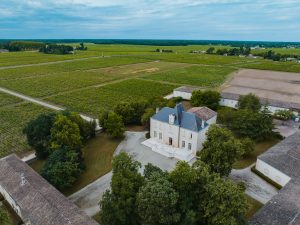
4 Bordeaux appellations to (re)discover
Bordeaux wines have graced tables all over the world for centuries. The region is of course home to the largest French appellation vineyard. But it is the quality of its grapes and its diverse terroirs that continue to captivate the taste buds of adventurous wine enthusiasts. Near the Garonne, the Dordogne, and the Gironde rivers, the vineyards of Bordeaux are home to a mosaic of rich and varied soils, a source of life for endless wine treasures. Specifically, 4 Bordeaux appellations that are well worth the aromatic detour…
Haut-Médoc AOC is a Bordeaux appellation, highly regarded for its aging potential.
On the left bank of the Gironde, south of Médoc, the Haut-Médoc AOC has exceptional gravel soils, enhanced by clay-limestone soils. There, the neighboring ocean and estuary naturally regulate temperature variations, shaping a hospitable microclimate: with its rays the sun fully envelops elegant merlot (majority grape variety) and structured cabernet Sauvignon, as well as petit verdot and cabernet franc (to a lesser extent).
The exceptional land of this region gives rise to wines that are only enhanced by extensive aging. As these wines mature in the cellar, their once-firm structure and tannins soften, resulting in a delightful smoothness draped with complex and rich aromas.
In Vertheuil, the bottles of Château Victoria perfectly exemplify this red Bordeaux appellation. On just under 150 acres, its HVE 3 vineyard draws its character from fine gravel soils and limestone subsoil. Its merlot and cabernet sauvignon from mature vines showcase an impressive depth of flavor, just like in the Château Victoria cuvée. A wine for aging, this Haut-Médoc is also distinguished as a Bourgeois Cru, a classification created in 1932 and revised in 2020, bringing together red wines from the Médoc region that combine quality and affordability.
Côtes de Bourg AOC: emphasizing fruitiness and roundness above all else
Crossing the Gironde river, another fantastic appellation reveals itself: that of the Côtes de Bourg, whose vineyard is one of the oldest in Bordeaux. Weather conditions here are milder than the rest of the right bank, thanks to the estuary’s influence. Furthermore, the vines are nestled on hillsides and benefit from limestone and sandy-clay soils, both draining and capable of maintaining water on the surface.
Red wines are also highly esteemed in this region: crafted from a blend of Merlot, Cabernet Franc, Cabernet Sauvignon, and even Malbec, they boast a delightful fruity bouquet, and their palate is warm, powerful, and round. With its 23 acres of organically farmed vineyard, Château Escalette gives pride of place to the purity of the fruit. The wine also bears the imprint of the estate, carved around merlot, cabernet sauvignon, and malbec vines. Nearby Château de Barbe offers a different but equally captivating version of the Côtes de Bourg appellation. As in its assemblages, Merlot dominates the 153-acre vineyard. Its suppleness, attributed to late clayey soils, can be savored notably through the estate’s eponymous cuvée.
Bordeaux AOC: an appellation full of surprising nuances
Unlike the two previous appellations, Bordeaux AOC wines can be made in vineyards across the region. When you combine such diverse terroirs and characteristics, you get new and exciting aromas at each tasting.
Bordeaux red wines are often supple, pleasantly fruity, and lightly structured. The grape varieties used are primarily Cabernet Sauvignon and Merlot, but also Cabernet Franc, Petit Verdot, Malbec, and Carmenère. Château de Barbe dedicates 32 acres of its vineyard to producing Bordeaux AOC wines. Chapelle de Brivazac cuvée honors grapes grown on clay-sandy soils, bordering the Gironde River. The assemblage exhibits a light and well-balanced structure, tinged with notes of cherry, thyme, and undergrowth.
In addition to the red wines, other areas, such as Château Gantonnet, create Bordeaux AOC whites, and rosés. On the Sainte-Radegonde hillside, the sandy-clay and limestone soils of its HVE3-certified vineyard are sprinkled with fine alluvium. These soils ensure effective drainage, maintain freshness, and nourish beautiful red and white grape varieties, reflecting the tradition of blending in Bordeaux.
Bordeaux Supérieur AOC: complex and assertive wines
Just like the wines of the Bordeaux appellation, those of the Bordeaux Supérieur AOC can come from any plot in the Bordeaux vineyard. However, its specifications impose more constraints on winegrowers, and only red and white wines are allowed in this appellation.
Red wine is still the most common. The grape varieties allowed are identical to that of the Bordeaux appellation. However, the resulting wines are typically more robust and complex. Château Guillot, Bordeaux Supérieur Red Château Gantonnet, wonderfully illustrates this type of profile. The wine’s well-structured character, and woody accents, come from the Merlots and Cabernets cultivated on a heavy clay plateau with a limestone subsoil.
Each of these 4 Bordeaux appellations – Côtes de Bourg, Haut-Médoc, Bordeaux, and Bordeaux Supérieur – naturally abounds with many other facets that are sure to surprise you… Among them, the vintage remains a key factor. Now you can dive into the 2022 harvest at our Bordeaux Châteaux!







